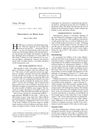TLDR Minoxidil can promote hair growth in hairless mice.
The study explored the use of hairless mice as a model to evaluate the effects of minoxidil on hair growth. Hairless mice typically lose their hair due to a defect in the first catagen phase, which prevents the papilla from reconnecting with the follicle, resulting in permanent hairlessness. The research aimed to determine if minoxidil could prevent this follicular defect, with the presence of a second pelage serving as an indicator of success. The study involved applying minoxidil topically to Skh-hairless-1 neonate and weanling mice to assess its potential in promoting hair growth.
12 citations
,
October 1988 in “Clinics in dermatology” The mouse model could be useful for baldness research and testing treatments like testosterone, cyproterone acetate, and minoxidil.
55 citations
,
June 1987 in “PubMed” Cyclosporin A significantly increases hair growth in certain areas of mice.
 46 citations
,
May 1986 in “Seminars in Reproductive Medicine”
46 citations
,
May 1986 in “Seminars in Reproductive Medicine” Testosterone and dihydrotestosterone affect hair growth, and new techniques like the folliculogram help study it, but fully understanding hair growth is still complex.
January 2007 in “Strait Pharmaceutical Journal” Water-soluble minoxidil effectively promoted hair growth in mice.
 1 citations
,
September 2002 in “PubMed”
1 citations
,
September 2002 in “PubMed” Minoxidil helps stimulate hair growth and reduce hair loss in women with androgenic alopecia.
January 2002 in “Journal of the Korean Medical Association” Recent research has provided important insights into hair growth and hair loss treatments.
 370 citations
,
September 1999 in “The New England Journal of Medicine”
370 citations
,
September 1999 in “The New England Journal of Medicine” Finasteride and minoxidil are effective for hair loss, but continued research is needed for better treatments.
35 citations
,
January 1990 in “PubMed” Cyclosporin A boosts hair growth in nude mice, but minoxidil does not.


